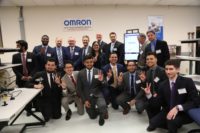Quality professionals like what they do. According to respondents from Quality’s14th annual State of the Profession Survey, half of respondents said they are highly satisfied with their job and 44% said they are moderately satisfied.
Along with being satisfied, respondents also are experienced—one-third said they had been in the industry for more than 25 years. The survey aims to discover trends in employee compensation, work hours, and job satisfaction, along with a profile of the quality demographic. Learn what quality professionals said about their company, industry, and career in this year’s survey.
Industries and Companies
First, let’s look at the respondents’ industries and companies. Fabricated metal products is the most common industry for respondents, with 16%; followed by aerospace by 13%; plastics and rubber came in at 11% and so did miscellaneous manufacturing; and 10% with medical equipment and supplies. Other industries followed: machinery; motor vehicles, body, trailer and parts; electrical equipment and components; transportation; computers.
More than a third of respondents work for companies that manufacture original equipment (OEMs), 34% at components and parts manufacturers, and 18% at job shops.
In terms of revenue, more than half of respondents have revenues between one and $49 million. The mean was $837.8 million; while the median was $23.5 million.
Two-thirds of respondents come from companies of less than 500 employees, with the mean company size coming in at 9,305 employees and a median of 150. For almost half (48%) of respondents, their companies remained the same size, and companies increased for 40%. Only 13% saw a decrease in company size.
Shopping for New Products
When considering purchases, the quality/product assurance group is most likely to be responsible for making purchase decisions. Over half (51%) of the respondents indicated the quality product and assurance control workers made purchasing decisions, but among all the groups who make purchasing decisions, their most common involvement is recommending or evaluating brands and models.
In looking ahead to resources planned for next year, just over half (52%) don’t expect to change the amount of their resources, but 42% said they do plan to increase their resources, primarily in gages. Gages topped the list at 55%, followed by measurement software at 33%, laser measurement equipment at 25%, coordinate measuring machines at 21%, form measurement and video measurement both at 20%, and surface finish measurement equipment at 18%. Other resources planned to be increased by 10% to 17% include white/structured light, measuring microscopes, and optical comparators.
Forty-two percent of respondents indicated that they were more comfortable waiting for others to successfully adopt a technology before trying it themselves. Only 11% said they were willing to be on the leading edge of technology adoption, though 33% said they were willing to be one of the early leaders. Fourteen percent said they would likely be one of the last to use it.
Quality Around the World
Just about half of respondents (49%) have production in the United States only. China (30%) and Mexico (25%) were the next most-common locations, followed by Canada, Germany, India, the United Kingdom, Brazil, Japan, France, Italy, Taiwan, Australia and Russia. Respondents also indicated that they have production locations in other European countries, Central and South America, the Middle East and Africa.
But where do the respondents themselves work? Just under half (48%) work in the Midwest, followed by the South at 20%, the Northeast at 19%, and the West at 12%.
A Quality Profile
The average age of respondents is 52 years old. Forty-one percent have earned a bachelor’s degree, 20% a master’s degree, 15% have an associate’s degree, and only 2% have received a Ph.D. Nine percent have taken certification programs and 12% have a high school education.
A quarter of respondents have received an ASQ certification, and 28% have received a Six Sigma green belt, black belt, master black belt, and/or champion certification.
As for their primary job function, the majority of respondents said they are in quality management (37%) or quality engineering (18%). Twelve percent are in corporate management, 8% were in manufacturing or supply chain management, 7% in engineering, 5% in manufacturing engineering, 3% in research and development, and 2% in purchasing.
Most respondents had been at their current company for 15 or fewer years, with a mean of 13 years. Sixty-two percent have been in the industry for at least 16 years, with a mean of 21 years. Clearly, this is an experienced crowd.
Two-thirds of respondents supervise others, with 46% supervising less than
five people. The mean number of people under their supervision was 12.
And how much do they work? Twenty percent indicated they work more than 50 hours a week, with the mean hours worked coming in at 47 hours. Most respondents said their hours worked have remained the same from last year, although a quarter said their hours worked had increased, by an average of 7 hours more.
At work, the majority said they had quality related responsibilities, with 74% saying implementing solutions to problems is a responsibility. Time constraints were the top issue interfering with their work, cited by 56%. Three-quarters of respondents said they were a member of at least one quality team or committee.
How Is It Going?
Respondents said they are happy at work, with 51% saying they are highly satisfied, 44% saying moderately satisfied and only 5% saying not at all satisfied. One of the most important job attributes, cited by 64%, was a feeling of accomplishment, followed by a good relationship with colleagues at 50%, and salary by 41%. Other positive job attributes followed, including technical challenges, ability to try new or creative approaches, job security, a pleasant work environment, and a chance to be a team leader.
One of the largest job concerns was economic conditions, cited by 48%, followed by management support at 41%, and a sufficient operating budget at 33%. They were also concerned about keeping current on technology, job security, keeping current on regulations, salary, and outsourcing and privatization.
Salary and Benefits
In terms of salary, the mean annual salary was $77,242. More than half of respondents receive an annual bonus, with a mean bonus of almost $11,000.
Over half of respondents reported a salary increase during the past year, on average by about 5%. Fifty-eight percent of respondents expect their salary to increase at their next performance review.
For those whose salary did not increase, economic conditions were cited as one of the top reasons. Overall company and personal performance were the top factors to lead to a change in salary.
Along with salary, 91% of respondents received health care through their employer, 90% receive paid vacation, and 80% receive 401(k) matching.
In addition, 62% received some type of training in the past year. ISO, FDA and other regulatory certifications were the most common type of training received, followed by training in methodologies such as Six Sigma, management, software or PC, and equipment operation or repair.
And quality professionals are interested in learning. Certifications and problem-solving were cited by 41% and 40% of respondents, respectively. They were also interested in working on time management, teamwork, employee supervision, finance and accounting, public speaking, and writing reports and proposals.
Methodology
The survey was conducted by BNP Media’s market research division, in association with Quality, from March 24 to April 7, 2014. Active, qualified subscribers were sent an email survey, with a response rate of 1.7%.
















